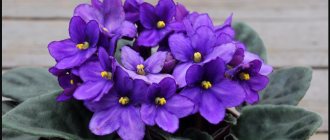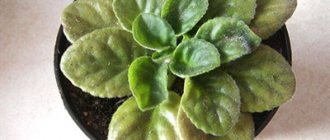Photo from the site: ogorodko.ru
It happens that, seduced by sellers’ stories and pictures of wild and bright violets blooming, we buy the treasured pot, carefully take it home and begin to wait for the violet to bloom, but this does not happen. The velvety green leaves are still pleasing to the eye, but the plant stubbornly refuses to bloom, no matter how hard we try. So why doesn’t violet bloom at home, what does it lack, and what could be done so that this capricious beauty still deigns to throw out its buds and please us with delicate petals? This is exactly what I want to talk about in order to finally find out what the reason is and how to deal with it.
Violet brings exceptional benefits
Violet is associated with something fabulous and magical:
- Brings harmony to the family.
- Relieves negative thoughts.
- The smell relaxes the body and pleases the soul.
- For lonely people it can improve their personal life.
- It has a beneficial effect on children and calms their emotional state.
- Helps improve mood.
- Treats bronchitis.
- Used for vascular diseases.
- The leaves can reduce the temperature.
- Relieves headaches.
Interesting fact: thanks to this flower, the romance between Napoleon Bonaparte and his lover began.
Violet is an unpretentious plant, but needs proper care. If you care for it incorrectly, the flower may die. There is a sign that violets bloom only in close-knit families.
Diseases and pests
Fungal infections, diseases and pests often affect flowers.
| Disease/pest | Manifestation/Causes | Corrective measures |
| Gray rot | A gray, fluffy coating appears on the leaves and petioles. Temperature changes, abundant and frequent watering with cold water. | Treated with fungicides (Fitosporin, Agat, Thiram). |
| Fusarium | The roots rot, the violet does not bloom, the leaves turn gray and then fall off. Water abundantly with cold water. | Benomyl and Fundazol are used. |
| Rust | Yellow spots on the outside of the leaves. Lack of sun in winter. | Infected parts are removed and Baktofit, Topaz are used. |
| Powdery mildew | White coating on the plant. Lack of light, low temperature in the room, dust. | Treated with Benlate. |
| Spider mite | Red dots. Dry air. | They use Apollo, Neoron. At the first stage, folk remedies: a decoction of onion peels, vodka. |
| Cyclamen mite | There are yellow, round spots on the leaves. High humidity. | |
| Aphid | Green insects, they drink the juice from the plant. Taking the plant outside or into contaminated soil. | Mospilan and Intavir are used. |
| Chervetsy | There are red, small spots on the violet. Dry air. | Spray with soap solution and Fitoverm. |
| Shchitovka | The leaves are red-brown below, yellow above. Infected from a new plant. | Young violets sometimes have to be destroyed; adults are helped by insecticides (Karbofos, Aktar). |
| Thrips | Light brown pollen on the plant. Airing, another flower. | Treated with Fitoverm. |
Correct flower transplant
Once you bring the violet into the house, do not rush to place it with other plants. She loves solitude.
How to properly and carefully replant Saintpaulia? You need to take a pot a little larger than at the moment. Violets need to be replanted twice a year. Now we’ll tell you how to do this correctly:
- A day before transplanting, water the violet well with warm water.
- After this, we pull out the plant along with the soil and then plant it in a new pot.
- We free the roots from the ground and process them if necessary.
- We place the plant in a new pot and fill it with fresh soil up to the lower leaves.
- To fill the voids inside, shake the container lightly.
- The plant should be in a dark place for one day. This is how the violet gets used to the new place and all the wounds heal faster.
Top dressing
Two months after planting in store-bought soil, the flowers are fed. For this purpose, complex fertilizers are purchased. Dilute them with water in accordance with the instructions, but in larger quantities than indicated, and water them under the leaves so that the liquid does not get on them, or through a tray. In this case, the soil is first moistened.
Young flowers need nitrogen fertilizers, and for flowering - potassium-phosphorus fertilizers. Feed twice a month during the flowering period, once a month at rest.
Creating a comfortable environment for violets
The plant needs long-term lighting of at least 10-12 hours. Bright sunlight is dangerous for violets; the leaves get burned and can become sick. The best location for a flower is on shelves where there is no bright sun . The temperature in the room should not exceed 24 degrees.
High humidity is required, approximately 55-63%. In winter, it is better to remove the pot from the windowsill, especially if there is a heating system nearby. The air around the flower must be sprayed, but not on the plant itself. The flower is placed in a tray with wet expanded clay. With low humidity, the buds develop slowly.
The plant is very demanding when it comes to watering. Violets like fairly infrequent watering - about once every 6-9 days. The water must be clean, settled, and must correspond to a certain temperature. Filtered water is also suitable for irrigation. It is not advisable to spray the leaves to avoid the risk of fungal infections.
When do violets begin to bloom?
- Violets have long become habitual “inhabitants” of the window sills of our apartments and houses. However, they could rightfully be called “settlers”, because their homeland is East Africa. These plants, pleasing to the eye with their eight to nine-month flowering, are called Uzambara violet or Saintpaulia.
- They can be either monochrome or multi-colored - in Russia alone there are more than 200 species. African climatic conditions suit them much more than Russian ones. Therefore, you should arrange conditions on your windowsill that are as close to tropical as possible. And then they will bloom for a long time - to the delight of amateur flower growers.
Types of violets
- There is no need to panic prematurely if violets do not bloom for some time, because a young Saintpaulia will need to grow for about a year before its first buds appear. Older flowers need to rest from time to time, this usually happens from the last month of autumn until February - during this period the plants increase their leaf mass.
- Contrary to popular belief about the unpretentiousness of violets, this is far from the case. If you want them to bloom for the entire period allotted for this, you will need to take proper care of them.
Without sufficient light, heat, high humidity and fertilized soil, violets do not bloom or bloom poorly.
Flowering period
It is impossible to pass by and not pay attention to the beautiful cap of violet flowers; it involuntarily attracts the eye.
What needs to be done to achieve abundant flowering? One leaf contains one flower, we need to remove the top row of peduncles, so we get new ones.
When growing the second row of flowering shoots, we repeat the plucking procedure. And we leave the third tier if the number of flower shoots that appear is satisfactory. If you want more, then remove the third row completely.
After removing the flower buds, the violet changes in growth. To achieve good flowering, you need to form a rosette and process:
- lateral shoots on the stem;
- leaves that are in the first row;
- and those that interfere with the symmetrical development of the rosette.
When the plant grows and gains the required volume, we leave the buds that have appeared. After 5 months, the flower reaches a beautiful blooming cap.
Remember that the plant can bloom only in a well-groomed outlet. To do this, you need to comply with all the conditions at the initial stage of development.
Illuminated shelves for violets
In such conditions, plants not only bloom beautifully, but also grow faster. Lighting is organized using specialized lamps for illuminating plants, providing the plantings with the necessary emission spectrum and luminous flux.
To make violets bloom, for rosettes of standard sizes, the lamps are hung at a height of 20 cm from the pots, and if the collection has miniature varieties, the lamps are lowered to 15 cm.
Such lighting provokes plants to form the primordia of flower stalks. When they appear, the lamps are raised, otherwise, in addition to the buds, the entire green part will also develop intensively, distracting the forks from the flowers.
At the same time, experienced gardeners remind that different varieties have different lighting needs. If the collection contains rosettes with light or variegated foliage, such plants require less light flux than violets with rich green leaves.
Therefore, the best option is if the florist has a specialized rack at his disposal, where on a shelf with backlight the violet can find a worthy place, according to his requests and needs.
How to increase violet reproduction from leaves
Propagating this wonderful flower is not difficult at all. You can ask for a leaf for brood or cut it from an existing flower. Favorable time is from February to May. Any healthy leaf from the top or middle rows is suitable for brood. The sheet must be undamaged.
Propagation of the shoot in a container of water
- We make an oblique cut at the cut leaf, the stem is pointed at the end.
- Then rinse under water and dry. Activated carbon can be used to process the cut.
- Next, take a convenient container: fill a small jar, shot glass or other container with water.
- We settle or filter the water.
- We immerse the stem in water about 1 cm and wait; after four weeks or even less, the first roots appear.
- The water must be changed once a week.
Substrate propagation of violet leaf
- We prepare the cuttings as in the first method.
- You can take a plastic glass, then cut out a small hole for drainage.
- The substrate must be moist.
- The cutting should be planted a little more than one cm.
- A glass with a branch is placed on the tray.
- Then pour water into the pan.
- The shoot should not dry out; to do this, add water in a timely manner.
- We create a small greenhouse, cover it with polyethylene and make small holes for air to pass through.
- We are waiting for the appearance of small leaves and transplanting the violets into the ground.
Violet – loves caring attitude. If the plant feels good in the created conditions, it will show itself in all its glory.
Why doesn't the violet bloom?
Saintpaulia is considered a capricious flower. If there is insufficient or excessive lighting, improper feeding or an unsuitable microclimate, it will not form buds.
The reason why the violet does not bloom may be an incorrectly selected substrate or untimely replanting of the flower. Saintpaulia does not respond well to rich, dense soil. In such soil, its root system begins to rot. Replanting should be done every 1.5-2 years, otherwise the overgrown bushes will lack nutrients. In this case, Saintpaulia weakens and stops blooming completely.
How to protect violets from diseases
It is not difficult to care for the plant at home, but if you neglect the rules, problems may arise and, accordingly, the flower will die. The irrigation regime must be observed; lighting and soil composition play an important role.
Let's look at the most important things that need to be observed. to fertilize the violet with fertilizing once every two weeks. Autumn is the time when the use of all vitamins should be reduced. Feeding is carried out in winter. It is better to purchase fertilizers with phosphorus.
After flowering, the violet is processed, dried leaves are removed, single buds are removed with scissors, or a bamboo stick with a blunt end is used so as not to damage the stem of the bush.
Fertilize correctly
Fertilizers for violets require complex fertilizers. This means that the nutritional mixtures must contain macro- and microelements.
Required Items
An indoor flower, however, like all representatives of the plant kingdom, needs a well-known triad: nitrogen, potassium, phosphorus. Information about them is summarized in the table:
| Name | Meaning | Deficiency Symptoms | Signs of excess |
| Nitrogen | Construction material necessary for increasing green mass. Particularly important for young plants at the stage of intensive growth | The foliage loses its bright, rich color and stops growth; lower old leaves die | In the summer, it provokes a rapid growth of greenery - stems and leaves, and the violet stops blooming. During the rest of the year, roots may die off |
| Potassium | Provides immunity: increases resistance to diseases and low temperatures. Maintains leaf turgor (pressure) | A yellow border appears along the edge of the leaf blade, the leaves curl and dry out. | Stopping the growth of the rosette, yellowing of the foliage |
| Phosphorus | Promotes the development of the root system and active flowering | The underside of the leaves turns purple. The root system weakens. Scanty flowering | Plants age prematurely, young leaves curl, buds fall off |
Ready-made complexes, as a rule, contain all the necessary substances
Calcium, sulfur, magnesium, and sodium are required in smaller quantities. Among the microelements, boron, iron, manganese, copper, zinc, and molybdenum are important. Thus, for flowering and seed formation, boron, manganese, copper, zinc, cobalt, aluminum and iron are needed; many of them are part of the pigments that provide the color of the petals.
Organic fertilizers
To feed violets for abundant flowering, many gardeners use organic matter, however, not everyone has the opportunity to use it regularly. Usually they take bird droppings (50 g) or cow manure (200 g), stir them in water (10 l) and infuse for 2-4 weeks. Before watering, concentrates are diluted with water at the rate of 100 g per 3-liter jar.
Nutrient solutions are carefully applied under the roots using a watering can with a long spout or a syringe.
Commercial mineral compounds
According to professionals, “Kemira Lux”, “Aquarin Flower”, “Ethisso”, “Master”, “Fertika Kristalon” are considered good fertilizers.
At the stage of preparing the soil mixture, in the absence of organic matter, you can add phosphorus additives, for example, superphosphate (1 tablespoon per bucket of soil).
Stimulants
On one of the sites for growing violets, I came across interesting advice from an experienced grower on the use of heteroauxin.
Heteroauxin (indoleacetic acid) is a growth hormone. In the plant itself, it is formed in the leaves, from where it moves to the growing organs. It stimulates the formation of roots in cuttings, promotes survival, wound healing, and is an excellent resuscitator for saving dying specimens.
To stimulate the growth of rosettes grown from leaf cuttings, use the following solution: 2/3 tablets of heteroauxin are dissolved in 1 liter of boiled water, diluted further in a ratio of 1:10. Water once a week for 3 weeks. Then the grown rosettes are planted in pots (9 cm in diameter) and fed weekly with a solution of complex fertilizers (the prescribed concentration must be halved).
The result of these manipulations will be beautiful, developed plants with a large number of buds.
Heteroauxin is sold in the form of powder, tablets and capsules
I also came across this recipe: 1 tablet of heteroauxin is dissolved in 5 liters of water. Children are watered once every 2-3 weeks.
Vitalizer HB 101 – stimulates growth and activates the immune system. This is an absolutely natural, non-toxic product, since it is an extract from plants.
Violet growers, by watering and spraying with a vitalizer solution, save their collections during the hot summer, and also accelerate the flowering of children. If 9-12 months pass from the leaf cutting to the first flowering, then with this preparation the violets will begin to bloom three times faster.
Fertilizer application methods
The main method of fertilizing Saintpaulia is root . It is a regular watering, but with a solution of nutrients. You need to fertilize violets by adhering to the following recommendations:
- Do not feed sick or weak plants.
- Newly transplanted plants begin to fertilize after 2 weeks.
- The soil in the pot must be moist.
- Several types of fertilizers are not used at the same time.
- When feeding with ready-made complexes, it is not recommended to make a solution of the concentration as specified by the manufacturer in the instructions for the drug - it is better to prepare a weaker one.
When watering with nutrient solutions, as with normal watering, the main thing is not to overdo it.
the foliar (by leaf) method. It is used when signs of deficiency of a certain element are noticed on the plant, and you do not want to cause possible harm by completely fertilizing it. The nutrient solution is diluted with clean water at a temperature of 25...30 ℃ 5 times (or according to the instructions for the drug) and the leaves are sprayed from the outside and inside with a spray bottle. Sprayed plants should not be placed in the sun, they should be protected from drafts: they should dry completely.
Saintpaulia feeding schedule
The frequency of fertilizing is determined by constant growth, frequent flowering and rapid depletion of the soil. It is important to be systematic and apply fertilizers at regular intervals so as not to harm the plant.
The feeding schedule depends on the general condition of the plant, time of year, temperature
Despite the fact that Saintpaulias do not have a pronounced dormant period, in autumn and winter all processes proceed more slowly, which means that fewer nutrients are required. It is also known that the growth and development of violets practically stops at ambient temperatures below 15 ℃. In such a situation, there is no point in fertilizing - the elements will precipitate in the form of salts.
Experienced violet growers adhere to the standard scheme:
- winter - once a month;
- March – twice;
- April, May - three times a month;
- summer - every week;
- in autumn - once every two weeks.
To simplify and avoid confusion, it is enough to water with nutrient solutions once a month in the autumn-winter period and once every two weeks in spring and summer - this is also acceptable.
Types of fertilizers
It is better to use specialized medications; the label should say “Saintpaulia” or “Violet”. To feed a flower, it is not necessary to take expensive fertilizers; even professionals are happy to use cheap domestic ones.
Mineral
Before the first flowering, young violets should grow a good rosette of leaves. This requires nitrogen. To feed the starter, any complex preparations for ornamental leafy crops are suitable. In the future, they are used only when the vegetative organs have slowed down their development or show a clear lack of nitrogen.
Adult plants also need N, but in small doses. In flowering Saintpaulias, the emphasis is on phosphorus and potassium.
From inexpensive specialized preparations to feed violets, you can take a complete mineral complex with microelements, vitamins and amino acids “Mr. Color Saintpaulia”.
As a last resort, you can use fertilizer for ornamental flowering plants. It is diluted 2 times stronger than indicated on the package.
Organic
You need to buy organics in the store. They sell preparations based on peat or humates, such as:
- Stimulus;
- Reasil;
- Stimovit.
You cannot use infusions of mullein or bird droppings, although even printed publications sometimes recommend this:
- To feed an adult violet, you don’t need as much nitrogen as in the waste of birds, horses or cattle;
- How many other batteries are there is unknown;
- perhaps the “best” fertilizers are contaminated with pest larvae or pathogens;
- After the violets have been fed, there is a stench in the room for a long time.
Folk remedies
First of all, you should remember about succinic acid. Specialized plant care products are already being prepared on its basis, but a pharmaceutical preparation is also suitable: 1 g per 2 liters of water. Water violets weakened after illness or transplantation accompanied by damage to the roots twice a month.
Once or twice you can spill the Saintpaulia with a solution of hydrogen peroxide - no more than 30 ml per 1 liter. Action:
- the structure of the substrate improves;
- the violet's absorption of oxygen increases;
- immunity rises;
- additional energy for the plant;
- gentle disinfection of soil and roots.
Both products are not fertilizers. They will help a weakened plant, but are useless for a healthy violet.
To stimulate growth, Saintpaulia can be fed with yeast (50 g per 5 liters of water) instead of adding nitrogen-containing preparations. The plant will additionally receive amino acids.
What not to feed Saintpaulia
Ash is an excellent product for the garden. It is not suitable for indoor flowers: many components are presented in the form of poorly soluble salts, they settle on the walls of the pot, the exact composition is unknown.
If you feed the violet with the following means, it will bring nothing but harm to the plant:
- an infusion of banana peels, contrary to the claims of bloggers and authors of online articles, is more likely to cause the appearance of fungus gnats than to saturate the substrate with useful substances;
- sugar will make the peat stick together, and with proper care, the violet produces carbohydrates itself;
- tea or tea leaves lead to mold and attract midges, tannins inhibit growth processes;
- the slightest overdose of iodine will cause burns to the roots;
- B vitamins are found in many cheap drugs, and in adjusted dosages.
Is it possible to spray violets with water and why is it necessary?
One way to hydrate a plant is irrigation. However, this procedure should be carried out carefully, since if sprayed too frequently, the flowers become stained, lose turgor and dry out. In addition, drops of water hitting the growing point cause the death of Saintpaulia.
However, there are also positive aspects of irrigation. This is extremely useful for violets, because its natural habitat is areas with high humidity and heavy rainfall. After irrigation, any remaining moisture should be removed from the leaf blades, especially paying attention to the growing points. For these purposes, you can use a dry cloth.
What mineral components do violets need?
How to feed petunia for abundant flowering
Before applying any products, it is necessary to study the best way to fertilize violets for abundant flowering. Special, narrowly targeted fertilizers are perfect for Saintpaulias. It is necessary to select preparations containing minimal nitrogen levels. An excess of it in the soil will lead to a change in the color of the foliage and the appearance of uncharacteristic spots on them.
Florists recommend using liquid preparations for violets. They are much more convenient and easy to use. Also, due to their liquid structure, they are better distributed when applied.
Preparing useful drugs in the form of a dry powder takes much longer, and they dissolve less well. They must be prepared in advance and mixed thoroughly before adding to the soil. Finely dispersed fertilizers, which dissolve faster, are more convenient to use. The use of drugs that have a long duration of action is highly discouraged. They, of course, make care easier, but can be destructive for a very delicate violet.
Timely feeding of Saintpaulia
How to feed homemade violets to improve their condition and harmonious development? To get more flowers, it is recommended to water the violet with a composition containing phosphorus and potassium. To maintain the required level of chlorophyll, the substrate should be fertilized with sulfur and magnesium preparations.
On a note! Timely addition of calcium will enrich and improve the root system.
Common mistakes
Failure to follow care recommendations can lead to disastrous consequences. It is important to avoid the following mistakes:
- Fertilizing should be done only for healthy and well-developing flowers.
- Excessive addition of nutrients to the soil can lead to violet disease.
- Fertilizers are applied only after preliminary watering.
- Failure to comply with Saintpaulia nutritional rules.
- Improper spraying can damage the leaf blades.
Healthy flowering of Saintpaulia at home
Caring for violets consists not only of following the rules of cultivation, but also of timely application of fertilizing and fertilizers. The methods can be very diverse. Root or foliar application can be used. The choice of means depends not only on the specific situation, but on the preferences of the grower. Compliance with all the rules will allow you to get a real decoration for any home, which will delight you with its beautiful flowers for many years.
Water for irrigation
Not all water is suitable for watering violets. If it is hard and too mineralized, then soil salinization will occur, and spots or white coating will begin to form on the leaf blades. Water for watering or irrigation should be settled and at room temperature. It is advisable to use melt or rain water for these purposes.
You can soften the water using special filters, adding apple or table vinegar to it, or by adding wood ash or peat. Only this kind of water can be used to spray and water violets.











